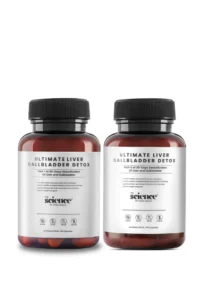Is grade 2 fatty liver dangerous? This is one of the most common concerns for individuals recently diagnosed with this condition. The straightforward answer is yes, it can be dangerous if ignored, but it is also highly manageable and in many cases reversible when addressed in time. Grade 2 fatty liver is the stage where fat deposits inside the liver have gone beyond the mild phase and are beginning to interfere with the normal functioning of this vital organ. If timely care is not taken, this stage can progress into severe liver diseases such as cirrhosis, liver cancer, or even complete liver failure.
Unlike Grade 1 fatty liver, which is mostly harmless and can go unnoticed for years, Grade 2 represents a turning point. The liver begins to show functional stress, and this is the moment when one must take corrective steps to protect long-term health. This article explores in detail whether grade 2 fatty liver is dangerous, how to recognize its symptoms, what causes it, how it can be diagnosed, and most importantly, how it can be treated and reversed naturally.
What is Grade 2 Fatty Liver?
To fully understand the seriousness of the condition, it is important to know how fatty liver disease is classified. Doctors divide it into three stages or grades:
- Grade 1 fatty liver is the earliest and mildest form, with fat deposits present but no significant damage to the liver.
- Grade 2 fatty liver is a moderate stage where fat buildup starts interfering with liver functions such as detoxification and metabolism.
- Grade 3 fatty liver is the most severe stage and often leads to scarring of the liver, known as fibrosis, and eventually cirrhosis.
Grade 2 is therefore considered the transitional stage. This is when patients must act because the liver is still capable of healing itself if proper lifestyle, nutrition, and treatment are followed. At this stage, asking the right question, is grade 2 fatty liver dangerous, becomes crucial because the answer motivates individuals to take preventive measures before the condition worsens.
Is Grade 2 Fatty Liver Dangerous?
So, is grade 2 fatty liver dangerous in the long term? The simple answer is yes, and here is why:
- It carries the risk of progressing into Grade 3 fatty liver, cirrhosis, or even liver cancer.
- It can reduce the liver’s ability to process toxins, regulate hormones, and store energy.
- It has strong links with lifestyle diseases such as diabetes, obesity, and cardiovascular problems.
- It weakens overall metabolism and immune response, leaving the body vulnerable.
However, the positive side is that Grade 2 fatty liver is not a point of no return. While it is dangerous if left untreated, it is also highly reversible with lifestyle modifications, proper diet, regular exercise, and medical supervision. Many patients who commit to consistent changes are able to fully reverse their condition within months.
Symptoms of Grade 2 Fatty Liver
One of the biggest challenges of fatty liver disease is that it often develops silently. Many people only ask themselves later, is grade 2 fatty liver dangerous if I have no symptoms? The truth is that symptoms are usually vague or absent in early stages but may include:
- Constant tiredness and reduced stamina
- Discomfort or mild pain in the upper right abdomen
- Feeling of bloating or heaviness after meals
- Unexplained weight gain or weight loss
- Poor appetite or frequent indigestion
- Yellowish skin or eyes in advanced cases
Since the symptoms are subtle, regular check-ups play a very important role. Liver Function Tests and ultrasounds are essential tools for detecting Grade 2 fatty liver before it progresses.
Causes of Grade 2 Fatty Liver
Grade 2 fatty liver can occur due to both alcoholic and non-alcoholic reasons. Alcohol-related cases are called Alcoholic Fatty Liver Disease, while non-alcoholic cases, which are more common today, are known as NAFLD or Non-Alcoholic Fatty Liver Disease.
Some of the most common causes include:
- Excessive alcohol intake that damages liver cells
- Obesity and overweight conditions that encourage fat deposits
- High cholesterol and triglyceride levels in the blood
- Type 2 diabetes and insulin resistance
- Sedentary lifestyle with little or no physical activity
- Poor dietary habits such as fried, sugary, and processed foods
- Genetic predisposition or family history of liver disease
- Imbalance in gut health leading to inflammation
Understanding the root cause is crucial because once you know why the condition developed, it becomes easier to reverse it naturally.
Diagnosis: How is Grade 2 Fatty Liver Detected?
Diagnosis of fatty liver disease requires a combination of medical tests and lifestyle history. Doctors may recommend:
- Liver Function Tests to measure enzymes and proteins in the blood
- Ultrasound imaging to visualize fat buildup
- MRI or CT scans for more detailed imaging
- Fibroscan to check stiffness and possible scarring of the liver
- Biopsy in rare cases when doctors need to confirm the level of inflammation or fibrosis
These tests help doctors determine whether the question “is grade 2 fatty liver dangerous” applies to your case, and they also guide the correct treatment approach.
Can Grade 2 Fatty Liver be Reversed?
One of the most hopeful answers for patients is that Grade 2 fatty liver is indeed reversible. Many individuals worry unnecessarily, asking again and again is grade 2 fatty liver dangerous beyond healing. The fact is that the liver has a strong ability to regenerate when supported with the right care.
Reversal is possible if you:
- Make lifestyle changes such as improving diet and exercising regularly
- Control underlying conditions like diabetes and high cholesterol
- Avoid alcohol and processed foods completely
- Follow natural healing therapies including yoga, meditation, and mindful eating
Timely action can completely clear fat buildup and restore normal liver function in as little as four to six months.
Treatment Options for Grade 2 Fatty Liver
There is no single medicine that cures fatty liver, but there are structured approaches that combine medical and lifestyle support.
Medical Support
- Doctors may prescribe supplements like Vitamin E, Choline, or amino acids to support liver healing
- Medicines may be given to control cholesterol, diabetes, or related conditions
Lifestyle Changes
- Following a balanced diet rich in vegetables and whole grains
- Exercising regularly with walking, yoga, or light strength training
- Ensuring proper sleep and stress management
Natural Healing Approaches
- Consuming detoxifying foods like green tea, turmeric, garlic, and ginger
- Practicing yoga, meditation, or deep breathing to reduce stress hormones
- Drinking enough water to support liver detoxification
Diet Plan for Grade 2 Fatty Liver
Food is one of the most powerful tools to reverse this condition. Patients often ask is grade 2 fatty liver dangerous if I improve my diet, and the answer is that nutrition plays a major role in healing.
Recommended foods include:
- Fruits such as apples, papaya, guava, and berries
- Vegetables like spinach, broccoli, kale, and cauliflower
- Whole grains including oats, quinoa, and brown rice
- Healthy fats from walnuts, flaxseeds, and olive oil
- Herbs and spices such as turmeric, ginger, and coriander
A diet rich in fiber, antioxidants, and healthy fats supports natural detoxification and reduces liver inflammation.
Prevention: How to Stop Grade 2 from Becoming Grade 3
Prevention is always easier than treatment. To stop progression:
- Maintain a healthy weight through balanced nutrition and exercise
- Go for regular medical check-ups and imaging tests
- Avoid alcohol and minimize processed or fried foods
- Follow sustainable lifestyle habits rather than temporary crash diets
- Stay active daily with at least 30 minutes of walking or exercise
By doing so, you ensure that the question “is grade 2 fatty liver dangerous” never becomes a personal health crisis.
When to See a Specialist
You should consult a liver specialist or gastroenterologist if you notice:
- Constant fatigue and weakness
- Yellowing of skin or eyes
- Sudden unexplained weight changes
- Severe or persistent abdominal pain
Early medical consultation allows for targeted treatment and prevents the condition from advancing to cirrhosis or cancer.
Heal Naturally with Smriti Kochar
If you’ve been diagnosed with Grade 2 fatty liver, don’t wait for it to worsen. With the right nutrition, lifestyle changes, and guided support, complete reversal is possible. Through my Ultra-Wellness Program, I’ve helped hundreds of Indians across the globe heal naturally, without medicines, within 4–6 months. Are you ready to unlock your healthiest version?
Start Your Healing Journey with Smriti Kochar Today
Conclusion – Is Grade 2 Fatty Liver Dangerous?
So, is grade 2 fatty liver dangerous? The clear answer is yes, it can be harmful if neglected, but it is also highly manageable and reversible. The liver has the ability to heal itself when supported with proper nutrition, lifestyle changes, and medical care. Patients who make consistent changes not only stop progression but often reverse the disease completely. The key lies in awareness, timely diagnosis, and long-term commitment to healthy living.
Read Our Latest Blogs
Is An Enlarged Liver Dangerous | How To Clean Liver Naturally |How To Detox Liver Naturally At Home | Is Eggs Good For Fatty Liver | What Is Grade 1 Fatty Liver | What Is Sgpt In Liver | Is Curd Good For Fatty Liver | Is Milk Good For Fatty Liver | Is Sugarcane Juice Good For Liver | Is Beer Good For Liver | Is Coconut Water Good For Liver
Frequently Asked Questions
Ans: Yes, if ignored, it can progress to severe liver conditions such as cirrhosis and liver cancer.
Ans: Yes, with strict lifestyle changes and medical guidance, the liver can regenerate and return to normal function.
Ans: On average, it can take four to six months of consistent diet and exercise to see significant improvement.
Ans: Avoid alcohol, fried foods, processed snacks, refined sugars, and high-fat fast foods.
Ans: No, progression is not inevitable. With early care, the disease can be stopped and reversed.
Ans: Yes, it can increase risks during pregnancy, so close medical supervision is essential.
Ans: Regular brisk walking, yoga, and light strength training are ideal exercises to reduce liver fat.
Ans: Yes, diabetes increases the risk of faster liver damage, so strict management of both conditions is important.





